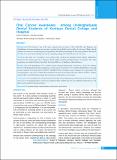Please use this identifier to cite or link to this item:
https://hdl.handle.net/20.500.14356/1322| Title: | Oral Cancer Awareness Among Undergraduate Dental Students of Kantipur Dental College and Hospital |
| Authors: | Pokhrel, Prenit Khadka, Bandana |
| Citation: | PokhrelP., & KhadkaB. (2020). Oral Cancer Awareness Among Undergraduate Dental Students of Kantipur Dental College and Hospital . Journal of Nepal Health Research Council, 18(3), 541-543. https://doi.org/10.33314/jnhrc.v18i3.2873 |
| Issue Date: | 2020 |
| Publisher: | Nepal Health Research Council |
| Article Type: | Original Article |
| Keywords: | Cancerous lesions Dental students Oral cancer Oral mucosa |
| Series/Report no.: | Jul-Sep 2020;2873 |
| Abstract: | Abstract Background: Oral Cancer is one of the most common form of cancer in the world. The early diagnosis and identification of cancerous lesions are necessary to reduce the morbidity and mortality of oral cancer. Today’s dental students are tomorrow’s dental surgeons and specialists who identify and manage the oral cancer patients. The aim of the study is to assess the knowledge and attitude regarding etiology and clinical features of oral cancer. Methods: The study was a descriptive cross-sectional study conducted at Kantipur Dental College, Kathmandu, Nepal after the ethical approval by Kantipur Dental College Institutional Ethical Review Committee. The study population were clinical students from third, fourth and fifth year of Bachelor of Dental Surgery. Results: Out of 101 participants, 67.3% students always examined their patient’s oral mucosa. Only 3.0% students felt very well-informed about clinical appearance of oral cancer. Of of total, 54.5% students identified floor of mouth as most common site of oral cancer and 60.4% identified border of tongue as most common site of oral cancer. Of total participants, only 22.8% students had examined oral cancer lesion before the study. Almost all (99%) students reported they wanted lacked knowledge and wanted more information on oral cancer. Conclusions: The undergraduate students lacked knowledge on the identification and detection of oral cancer. They were also not examining patient’s oral mucosa routinely. Many students did not have sufficient information on risk factors and associated oral cancer lesions. |
| Description: | Original Article |
| URI: | http://103.69.126.140:8080/handle/20.500.14356/1322 |
| ISSN: | JNHRC Print ISSN: 1727-5482; Online ISSN: 1999-6217 |
| Appears in Collections: | Vol. 18 No. 3 (2020): Vol. 18 No. 3 Issue 48 Jul-Sep 2020 |
Files in This Item:
| File | Description | Size | Format | |
|---|---|---|---|---|
| 2873-Manuscript-18856-1-10-20201115.pdf | Fulltext Article. | 154.1 kB | Adobe PDF |  View/Open |
Items in DSpace are protected by copyright, with all rights reserved, unless otherwise indicated.
